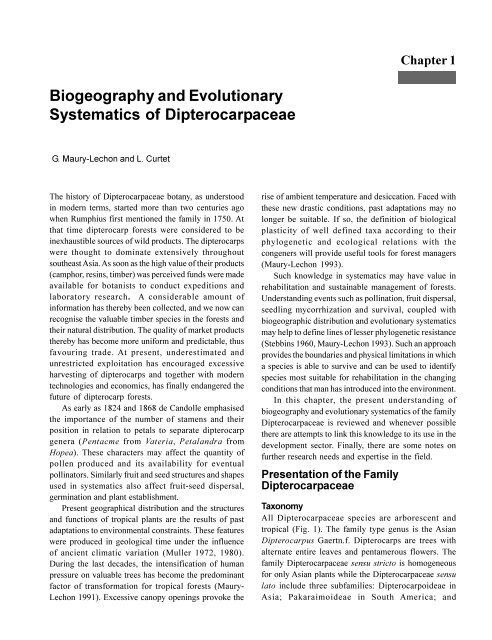A review of dipterocarps - Center for International Forestry Research
A review of dipterocarps - Center for International Forestry Research
A review of dipterocarps - Center for International Forestry Research
Create successful ePaper yourself
Turn your PDF publications into a flip-book with our unique Google optimized e-Paper software.
Biogeography and Evolutionary<br />
Systematics <strong>of</strong> Dipterocarpaceae<br />
G. Maury-Lechon and L. Curtet<br />
The history <strong>of</strong> Dipterocarpaceae botany, as understood<br />
in modern terms, started more than two centuries ago<br />
when Rumphius first mentioned the family in 1750. At<br />
that time dipterocarp <strong>for</strong>ests were considered to be<br />
inexhaustible sources <strong>of</strong> wild products. The <strong>dipterocarps</strong><br />
were thought to dominate extensively throughout<br />
southeast Asia. As soon as the high value <strong>of</strong> their products<br />
(camphor, resins, timber) was perceived funds were made<br />
available <strong>for</strong> botanists to conduct expeditions and<br />
laboratory research. A considerable amount <strong>of</strong><br />
in<strong>for</strong>mation has thereby been collected, and we now can<br />
recognise the valuable timber species in the <strong>for</strong>ests and<br />
their natural distribution. The quality <strong>of</strong> market products<br />
thereby has become more uni<strong>for</strong>m and predictable, thus<br />
favouring trade. At present, underestimated and<br />
unrestricted exploitation has encouraged excessive<br />
harvesting <strong>of</strong> <strong>dipterocarps</strong> and together with modern<br />
technologies and economics, has finally endangered the<br />
future <strong>of</strong> dipterocarp <strong>for</strong>ests.<br />
As early as 1824 and 1868 de Candolle emphasised<br />
the importance <strong>of</strong> the number <strong>of</strong> stamens and their<br />
position in relation to petals to separate dipterocarp<br />
genera (Pentacme from Vateria, Petalandra from<br />
Hopea). These characters may affect the quantity <strong>of</strong><br />
pollen produced and its availability <strong>for</strong> eventual<br />
pollinators. Similarly fruit and seed structures and shapes<br />
used in systematics also affect fruit-seed dispersal,<br />
germination and plant establishment.<br />
Present geographical distribution and the structures<br />
and functions <strong>of</strong> tropical plants are the results <strong>of</strong> past<br />
adaptations to environmental constraints. These features<br />
were produced in geological time under the influence<br />
<strong>of</strong> ancient climatic variation (Muller 1972, 1980).<br />
During the last decades, the intensification <strong>of</strong> human<br />
pressure on valuable trees has become the predominant<br />
factor <strong>of</strong> trans<strong>for</strong>mation <strong>for</strong> tropical <strong>for</strong>ests (Maury-<br />
Lechon 1991). Excessive canopy openings provoke the<br />
Chapter 1<br />
rise <strong>of</strong> ambient temperature and desiccation. Faced with<br />
these new drastic conditions, past adaptations may no<br />
longer be suitable. If so, the definition <strong>of</strong> biological<br />
plasticity <strong>of</strong> well defined taxa according to their<br />
phylogenetic and ecological relations with the<br />
congeners will provide useful tools <strong>for</strong> <strong>for</strong>est managers<br />
(Maury-Lechon 1993).<br />
Such knowledge in systematics may have value in<br />
rehabilitation and sustainable management <strong>of</strong> <strong>for</strong>ests.<br />
Understanding events such as pollination, fruit dispersal,<br />
seedling mycorrhization and survival, coupled with<br />
biogeographic distribution and evolutionary systematics<br />
may help to define lines <strong>of</strong> lesser phylogenetic resistance<br />
(Stebbins 1960, Maury-Lechon 1993). Such an approach<br />
provides the boundaries and physical limitations in which<br />
a species is able to survive and can be used to identify<br />
species most suitable <strong>for</strong> rehabilitation in the changing<br />
conditions that man has introduced into the environment.<br />
In this chapter, the present understanding <strong>of</strong><br />
biogeography and evolutionary systematics <strong>of</strong> the family<br />
Dipterocarpaceae is <strong>review</strong>ed and whenever possible<br />
there are attempts to link this knowledge to its use in the<br />
development sector. Finally, there are some notes on<br />
further research needs and expertise in the field.<br />
Presentation <strong>of</strong> the Family<br />
Dipterocarpaceae<br />
Taxonomy<br />
All Dipterocarpaceae species are arborescent and<br />
tropical (Fig. 1). The family type genus is the Asian<br />
Dipterocarpus Gaertn.f. Dipterocarps are trees with<br />
alternate entire leaves and pentamerous flowers. The<br />
family Dipterocarpaceae sensu stricto is homogeneous<br />
<strong>for</strong> only Asian plants while the Dipterocarpaceae sensu<br />
lato include three subfamilies: Dipterocarpoideae in<br />
Asia; Pakaraimoideae in South America; and

















